Submitted:
23 July 2024
Posted:
24 July 2024
You are already at the latest version
Abstract
Keywords:
1. Introduction
2. Materials and Methods
2.1. Materials
2.2. Preparation of Panels
2.3. Characterization of the Elaborated Panels
2.4. Statistical analyses
3. Results and Discussion
3.1. Water Absorption and Thickness Swelling
3.2. Determination of Modulus of Rupture and Modulus of Elasticity in Bending and of Bending Strength
3.3. Screw Withdrawal Resistance
3.4. Internal Bond
3.5. Density Profiles
4. Conclusions
Author Contributions
Funding
Institutional Review Board Statement
Informed Consent Statement
Data Availability Statement
Acknowledgments
Conflicts of Interest
References
- Wang, D.; Sun, X.S. Low Density Particleboard from Wheat Straw and Corn Pith. Ind. Crops Prod. 2002, 15, 43–50. [Google Scholar] [CrossRef]
- Mirindi, D.; Panthi, K.; Ph, D.; Nashay, T.; Thach, S.; Ph, D. A Review of the Evolution and Performance of Particleboard from Different Types of Organic Waste and Adhesives. 2024, 5, 740–749. [CrossRef]
- Wronka, A.; Kowaluk, G. Upcycling Different Particle Sizes and Contents of Pine Branches into Particleboard. Polymers (Basel). 2022, 14. [Google Scholar] [CrossRef] [PubMed]
- Pędzik, M.; Tomczak, K.; Janiszewska-Latterini, D.; Tomczak, A.; Rogoziński, T. Management of Forest Residues as a Raw Material for the Production of Particleboards. Forests 2022, 13, 1–12. [Google Scholar] [CrossRef]
- Reh, R.; Kristak, L.; Kral, P.; Pipiska, T.; Jopek, M. Perspectives on Using Alder, Larch, and Birch Wood Species to Maintain the Increasing Particleboard Production Flow. Polymers (Basel). 2024, 16, 1–32. [Google Scholar] [CrossRef] [PubMed]
- Nemli, G.; Kirci, H.; Serdar, B.; Ay, N. Suitability of Kiwi (Actinidia Sinensis Planch.) Prunings for Particleboard Manufacturing. Ind. Crops Prod. 2003, 17, 39–46. [Google Scholar] [CrossRef]
- Alamsyah, E.M.; Sutrisno; Sumardi, I. ; Darwis, A.; Suhaya, Y.; Hidayat, Y. The Possible Use of Surian Tree (Toona Sinensis Roem) Branches as an Alternative Raw Material in the Production of Composite Boards. J. Wood Sci. 2020, 66. [Google Scholar] [CrossRef]
- Wronka, A.; Kowaluk, G. Selected Properties of Particleboard Made of Raspberry Rubus Idaeus L. Lignocellulosic Particles. Ann. WULS, For. Wood Technol. 2019, 105, 113–124. [Google Scholar] [CrossRef]
- Wronka, A.; Kowaluk, G. Selected Physical and Mechanical Properties of Particleboards Produced from Lignocellulosic Particles of Black Chokeberry ( Aronia Melanocarpa ( Michx. ) Elliott ). 2020, 70, 60–70. [Google Scholar] [CrossRef]
- Iskanderani, F.I. Physical Properties of Particleboard Panels Manufactured from Phoenix Dactylifera-L (Date Palm) Mid-Rib Chips Using Ureaformaldehyde Binder. Int. J. Polym. Mater. Polym. Biomater. 2008, 57, 979–995. [Google Scholar] [CrossRef]
- Duran, A.J.F.P.; Lyra, G.P.; Campos Filho, L.E.; Bueno, C.; Rossignolo, J.A.; Alves-Lima, C.; Fiorelli, J. The Use of Sargasso Seaweed as Lignocellulosic Material for Particleboards: Technical Viability and Life Cycle Assessment. Buildings 2024, 14. [Google Scholar] [CrossRef]
- Mazlan Mohamed, T.; Mustafa Al Bakri Abdullah, M.; Muhammad, N.; Rozyanty, A. Sustainable Use of Cassava Plant Waste (Branches) as Raw Material for Bio-Composite Development: Particleboard Properties Due to Plant Maturity. ARPN J. Eng. Appl. Sci. 2016, 11, 6148–6160. [Google Scholar]
- Rios, P.D. angel.; Vieira, H.C.; Stupp, Â.M.; Del Castanhel Kniess, D.; Borba, M.H.; Da Cunha, A.B. Physical and Mechanical Review of Particleboard Composed of Dry Particles of Branches of Araucaria Angustifolia (Bertol.) Kuntze and Wood of Eucalyptus Grandis Hill Ex Maiden. Sci. For. Sci. 2015, 43, 283–289. [Google Scholar]
- Tichi, A.H. Investigation of the Use of Old Railroad Ties (Fagus Orientalis) and Citrus Branches (Orange Tree) in the Particleboard Industry. BioResources 2021, 16, 6984–6992. [Google Scholar] [CrossRef]
- Oh, Y.; Yoo, J. Properties of Particleboard Made From Chili Pepper Stalks. J. Trop. For. Sci. 2011, 23, 473–477. [Google Scholar]
- Yeniocak, M.; Goktas, O.; Ozen, E.; Gecgel, A.; Yapi, O.; Aydin, T.A.Ş. Improving Mechanical and Physical Properties of Particleboard Made from Vine (Vitis Vinifera L.) Prunings by Addition Reinforcement Materials. Wood Res. 2016, 61, 265–274. [Google Scholar]
- Guntekin, E.; Karakus, B. Feasibility of Using Eggplant (Solanum Melongena) Stalks in the Production of Experimental Particleboard. Ind. Crops Prod. 2008, 27, 354–358. [Google Scholar] [CrossRef]
- Lykidis, C.; Grigoriou, A.; Barboutis, I. Utilisation of Wood Biomass Residues from Fruit Tree Branches, Evergreen Hardwood Shrubs and Greek Fir Wood as Raw Materials for Particleboard Production. Part A. Mechanical Properties. Wood Mater. Sci. Eng. 2014, 9, 202–208. [Google Scholar] [CrossRef]
- Żabowski, B.; Kowaluk, G. Selected Properties of Particleboards Made of Different Cultivars of Apple Wood Particles. Ann. WULS, For. Wood Technol. 2023, 123, 131–142. [Google Scholar] [CrossRef]
- Mohd Ghani, R.S.; Osman, M.S.; Abdul Rani, A.I. Exploring the Potential of Nipah Palm Frond as Sustainable Raw Material for Eco-Friendly Particleboard Production. Clean. Circ. Bioeconomy 2024, 8. [Google Scholar] [CrossRef]
- Şahin, F.; Kaymakcı, A. Evaluation of the Mechanical and Physical Properties of Particleboards Manufactured from Rice Husk. Artvin Çoruh Üniversitesi Orman Fakültesi Derg. 2024, 25, 81–85. [Google Scholar] [CrossRef]
- Sutiawan, J.; Hadi, Y.S.; Nawawi, D.S.; Abdillah, I.B.; Zulfiana, D.; Lubis, M.A.R.; Nugroho, S.; Astuti, D.; Zhao, Z.; Handayani, M.; et al. The Properties of Particleboard Composites Made from Three Sorghum (Sorghum Bicolor) Accessions Using Maleic Acid Adhesive. Chemosphere 2022, 290, 133163. [Google Scholar] [CrossRef]
- Li, Y.; Hu, C.; Tu, D.; Chen, R.; Yun, H. Utilization of Lychee Pruning Timber as Alternative Raw Materials for Manufacturing Tubular Particleboard. Ind. Crops Prod. 2023, 203, 117092. [Google Scholar] [CrossRef]
- Bauta, J.; Vaca-Medina, G.; Delgado Raynaud, C.; Simon, V.; Vandenbossche, V.; Rouilly, A. Development of a Binderless Particleboard from Brown Seaweed Sargassum spp. Materials (Basel). 2024, 17. [Google Scholar] [CrossRef]
- Yalinkilic, M.K.; Imamura, Y.; Takahashi, M.; Kalaycioglu, H.; Nemli, G.; Demirci, Z.; Ozdemir, T. Biological, Physical and Mechanical Properties of Particleboard Manufactured from Waste Tea Leaves. Int. Biodeterior. Biodegrad. 1998, 41, 75–84. [Google Scholar] [CrossRef]
- Tryboi, O.V. Life Cycle Assessment of Heat Production From Willow Chips of Salix Viminalis L. in Ukraine. ВІДНОВЛЮВАНА ЕНЕРГЕТИКА. [CrossRef]
- Manzone, M.; Spinelli, R. Wood Chipping Performance of a Modified Forager. Biomass and Bioenergy 2013, 55, 101–106. [Google Scholar] [CrossRef]
- Jasinskas, A.; Šiaudinis, G.; Martinkus, M.; Karčauskienė, D.; Repšienė, R.; Pedišius, N.; Vonžodas, T. Evaluation of Common Osier (Salix Viminalis L.) and Black Poplar (Populus Nigra L.) Biomass Productivity and Determination of Chemical and Energetic Properties of Chopped Plants Produced for Biofuel. Balt. For. 2017, 23, 666–672. [Google Scholar]
- Kalembasa, D.; Malinowska, E.; Wysokiński, A. The Distribution of Zinc Nickel and Chromium in Biomass. Inżynieria Ekol. [CrossRef]
- Wang, Z.; Yan, W.; Peng, Y.; Wan, M.; Farooq, T.H.; Fan, W.; Lei, J.; Yuan, C.; Wang, W.; Qi, Y.; et al. Biomass Production and Carbon Stocks in Poplar-Crop Agroforestry Chronosequence in Subtropical Central China. Plants 2023, 12. [Google Scholar] [CrossRef]
- EN 323 Wood-Based Panels - Determination of Density; European Committee for Standardization, Brussels, Belgium, 1993;
- EN 310 Wood-Based Panels. Determination of Modulus of Elasticity in Bending and of Bending Strength; European Committee for Standardization, Brussels, Belgium, 1993;
- EN 319 Particleboards and Fibreboards. Determination of Tensile Strength Perpendicular to the Plane of the Board; European Committee for Standardization, Brussels, Belgium, 1993;
- EN 320 Particleboards and Fibreboards - Determination of Resistance to Axial Withdrawal of Screws; European Committee for Standardization, Brussels, Belgium, 2011;
- EN 317 Particleboards and Fiberboards – Determination of Swelling in Thickness after Immersion in Water; European Committee for Standardization, Brussels, Belgium, 1993;
- EN 312 Particleboards - Specifications; European Committee for Standardization, Brussels, Belgium, 2010;
- Rana, M.T. Feasibility Study of Brown Mustard (Brassica Juncea (l.) Czern) Plant as a Raw Material for Manufacturing of Particle Board. Int. J. Sci. Res. Manag. 2022, 10, 231–236. [Google Scholar] [CrossRef]
- Warmbier, K.; Wilczyński, A.; Danecki, L. Properties of One-Layer Experimental Particleboards from Willow (Salix Viminalis) and Industrial Wood Particles. Eur. J. Wood Wood Prod. 2013, 71, 25–28. [Google Scholar] [CrossRef]
- Şahinöz, M.; Aruntaş, H.Y.; Gürü, M. Production of Composite Particleboard From Waste Plum Pits (Prunus Domestica) and Improvement of Its Characteristics. Cellul. Chem. Technol. 2023, 57, 587–598. [Google Scholar] [CrossRef]
- Iždinský, J.; Salca, E.A.; Bekhta, P. The Use of Beech Particles in the Production of Particleboards Based on Recycled Wood. In Proceedings of the 11th Hardwood Conference Proceedings; University of Sopron Press; 2024. [Google Scholar]
- Hernándeza, D.; *, H.F.-P.; Cataldoa, F.; J. Gonzálezb Particle Boards Made with Prunus Avium Fruit Waste. ScienceDirecte 2020. [Google Scholar] [CrossRef]
- Warmbier, K.; Wilczyński, M. Resin Content and Board Density Dependent Mechanical Properties of One-Layer Particleboard Made from Willow (Salix Viminalis). Drv. Ind. 2016, 67, 127–131. [Google Scholar] [CrossRef]
- Kalaycioglu, H.; Deniz, I.; Hiziroglu, S. Some of the Properties of Particleboard Made from Paulownia. J. Wood Sci. 2005, 51, 410–414. [Google Scholar] [CrossRef]
- Hartono, R. ; Fradika Oktavianus Bernadi Siahaan; Tito Sucipto; Erwinsyah; Jajang Sutiawan Enhancement Quality of Particleboard from Oil Palm Trunk and Mahogany Sawdust with Layering of Talang Bamboo (Schizostachyum Brachycladumc). J. Sylva Indones. 2023, 6, 195–206. [Google Scholar] [CrossRef]
- Widyorini, R.; Umemura, K.; Isnan, R.; Putra, D.R.; Awaludin, A.; Prayitno, T.A. Manufacture and Properties of Citric Acid-Bonded Particleboard Made from Bamboo Materials. Eur. J. Wood Wood Prod. 2016, 74, 57–65. [Google Scholar] [CrossRef]
- Warmbier, K.; Wilczyński, A.; Danecki, L. Evaluation of Mechanical and Physical Properties of Particleboards with the Core Layer Made from Willow (Salix Viminalis). BioResources 2014, 9, 894–905. [Google Scholar] [CrossRef]
- Bektas, I.; Guler, C.; Kalaycioğlu, H.; Mengeloglu, F.; Nacar, M. The Manufacture of Particleboards Using Sunflower Stalks (Helianthus Annuus l.) And Poplar Wood (Populus Alba L.). J. Compos. Mater. 2005, 39, 467–473. [Google Scholar] [CrossRef]
- Hegazy, S.S.; Aref, I.M. Suitability of Some Fast-Growing Trees and Date Palm Fronds for Particleboard Production. For. Prod. J. 2010, 60, 599–604. [Google Scholar] [CrossRef]
- Pędzik, M.; Auriga, R.; Kristak, L.; Antov, P.; Rogoziński, T. Physical and Mechanical Properties of Particleboard Produced with Addition of Walnut (Juglans Regia L.) Wood Residues. Materials (Basel). 2022, 15. [Google Scholar] [CrossRef]
- Kowaluk, G.; Szymanowski, K.; Kozlowski, P.; Kukula, W.; Sala, C.; Robles, E.; Czarniak, P. Functional Assessment of Particleboards Made of Apple and Plum Orchard Pruning. Waste and Biomass Valorization 2020, 11, 2877–2886. [Google Scholar] [CrossRef]
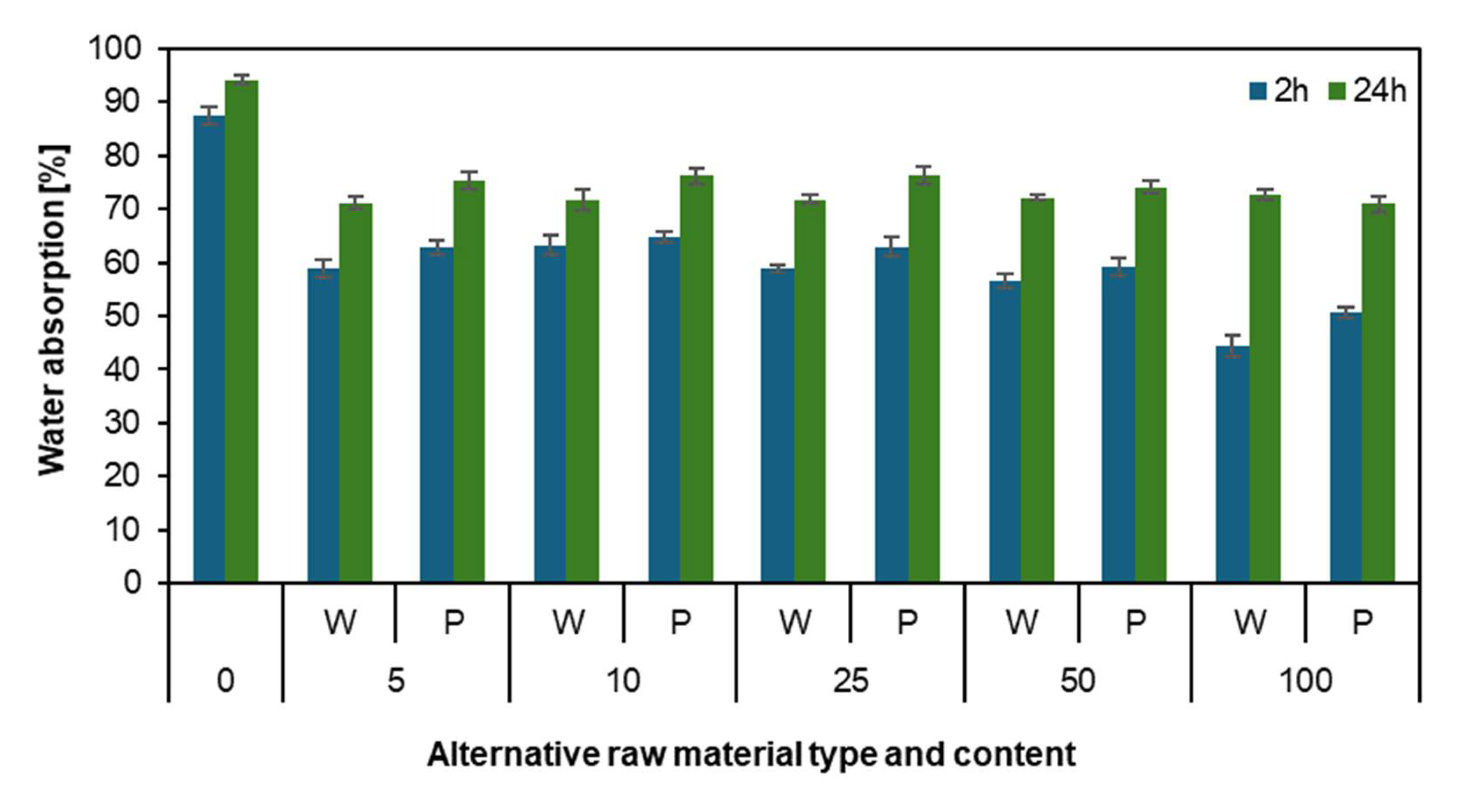
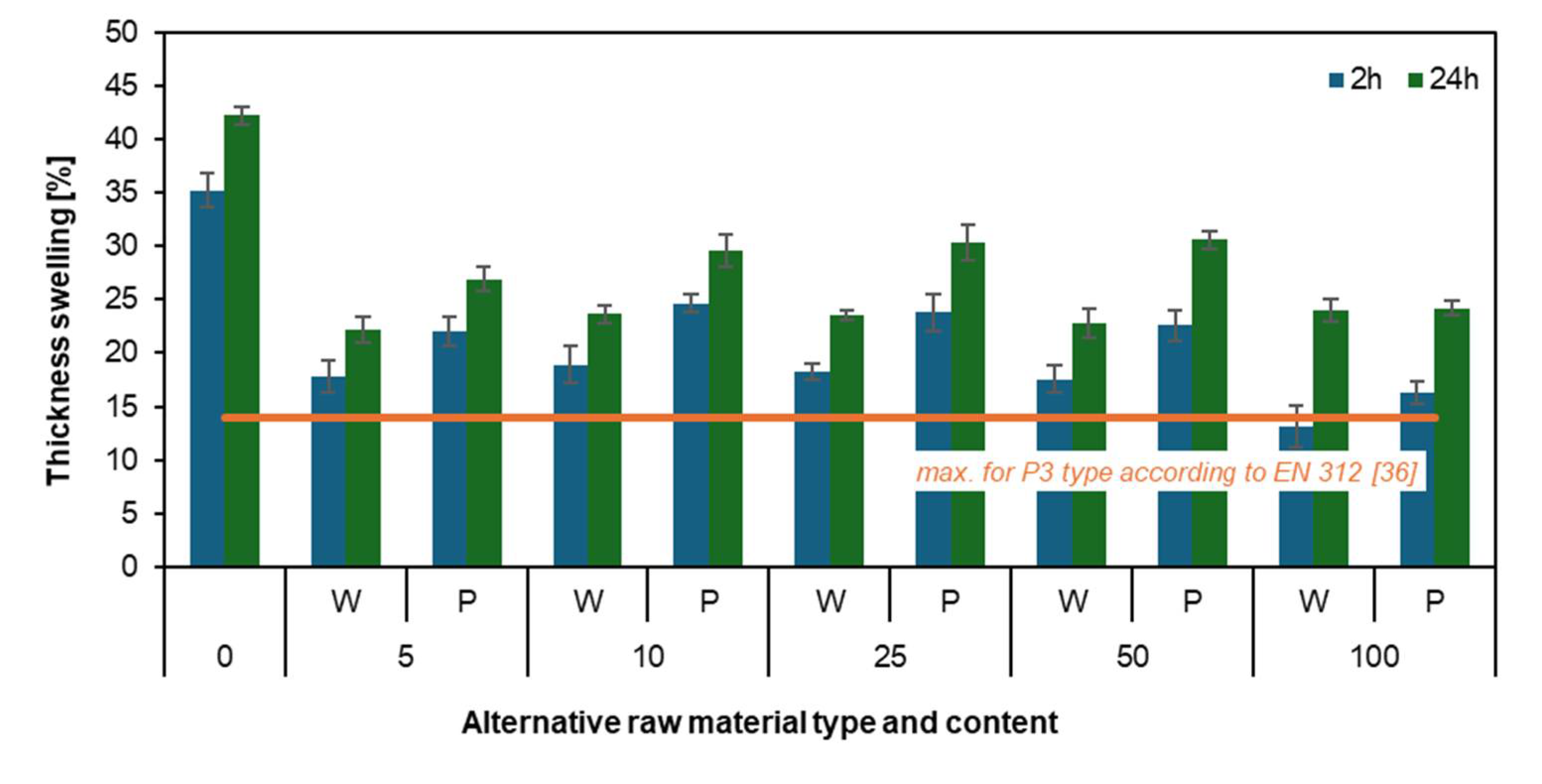
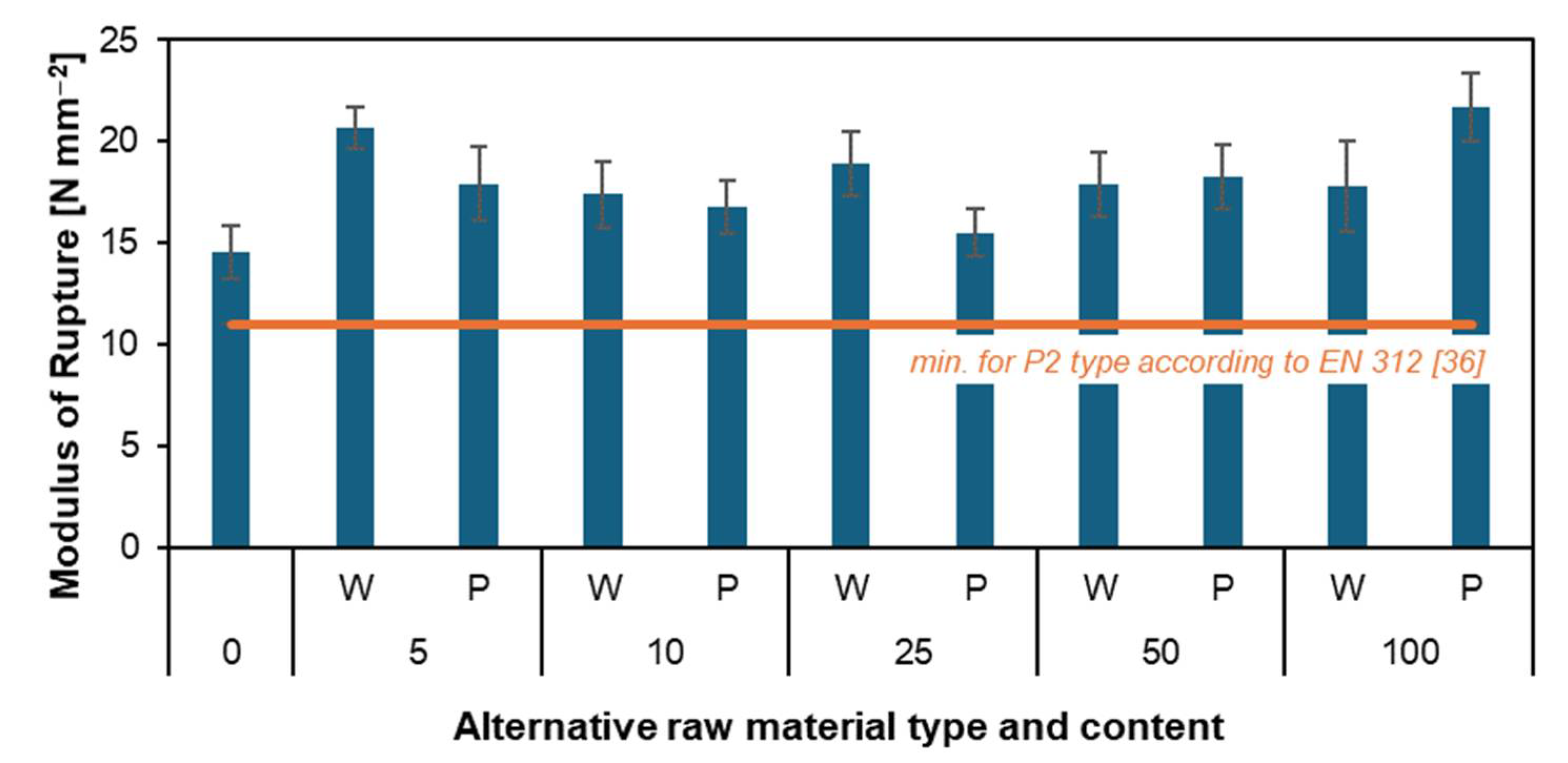
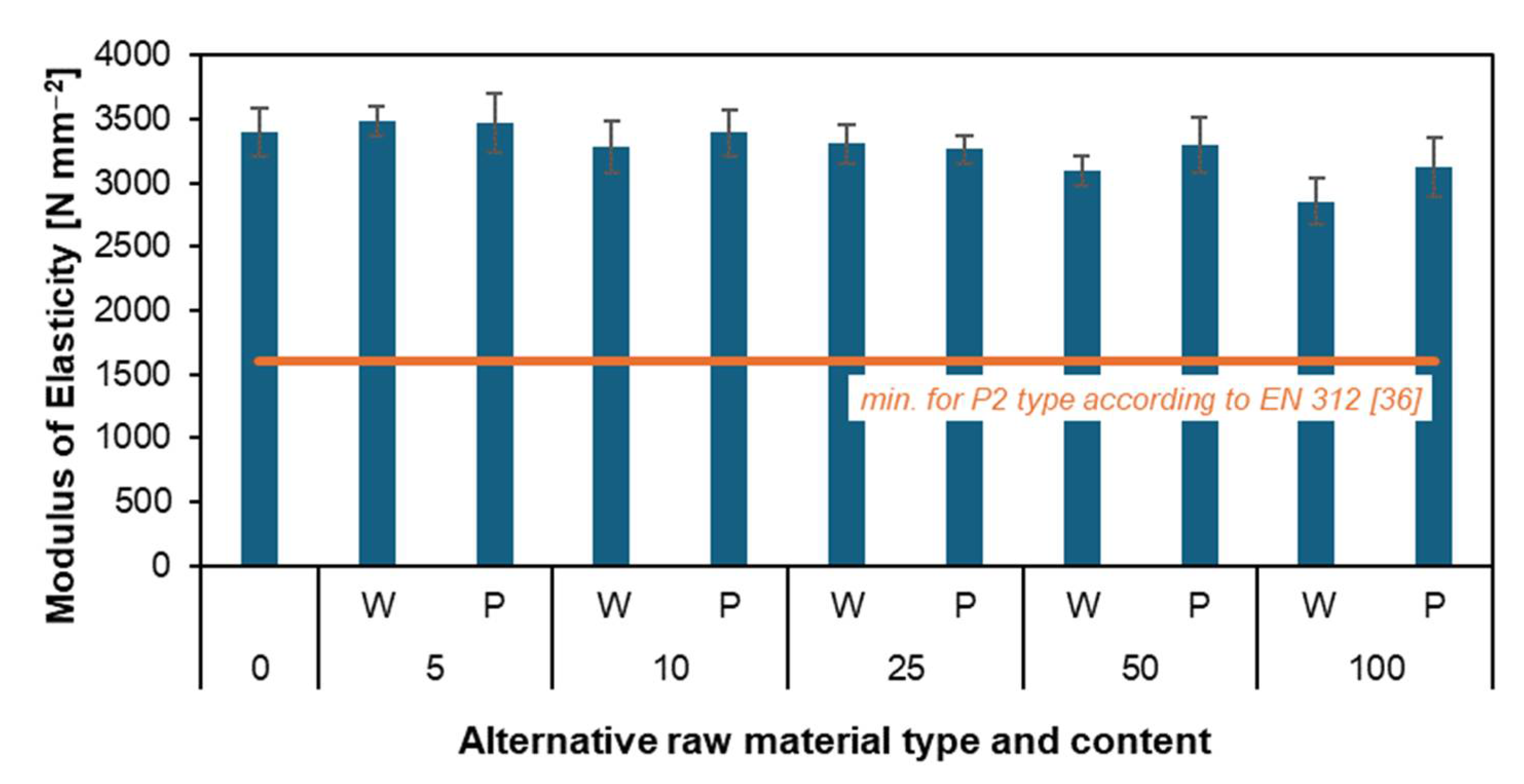
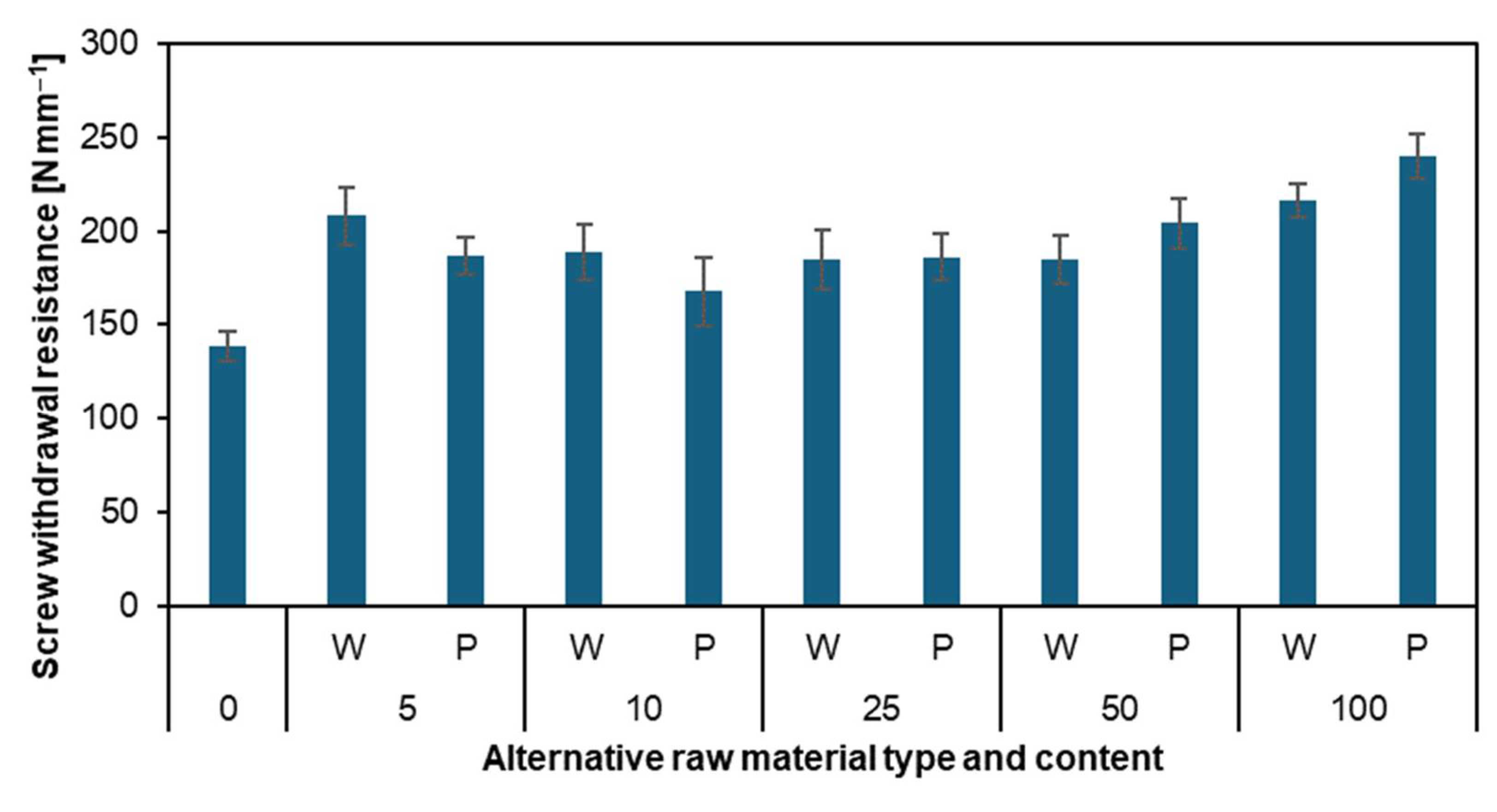
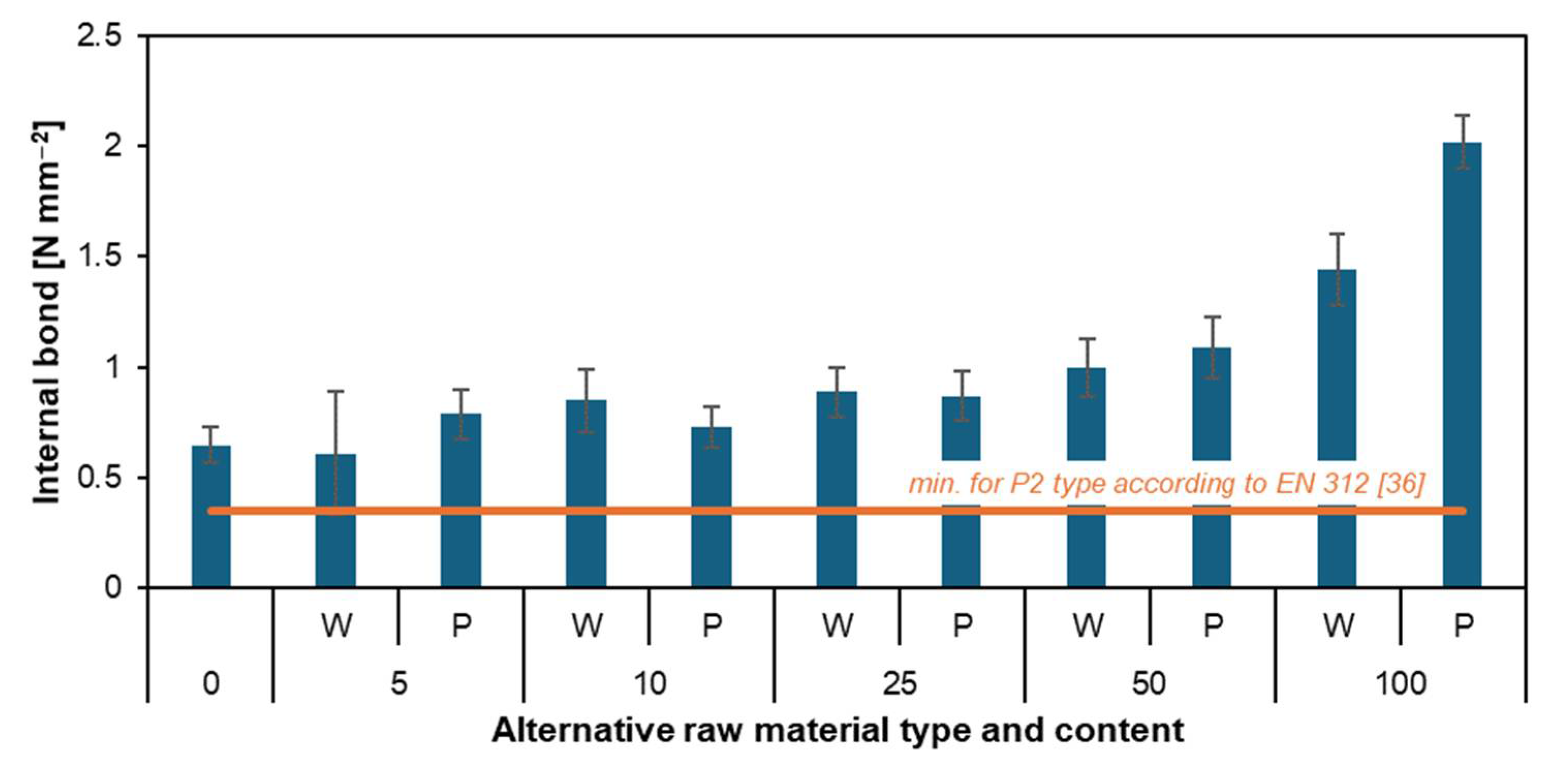
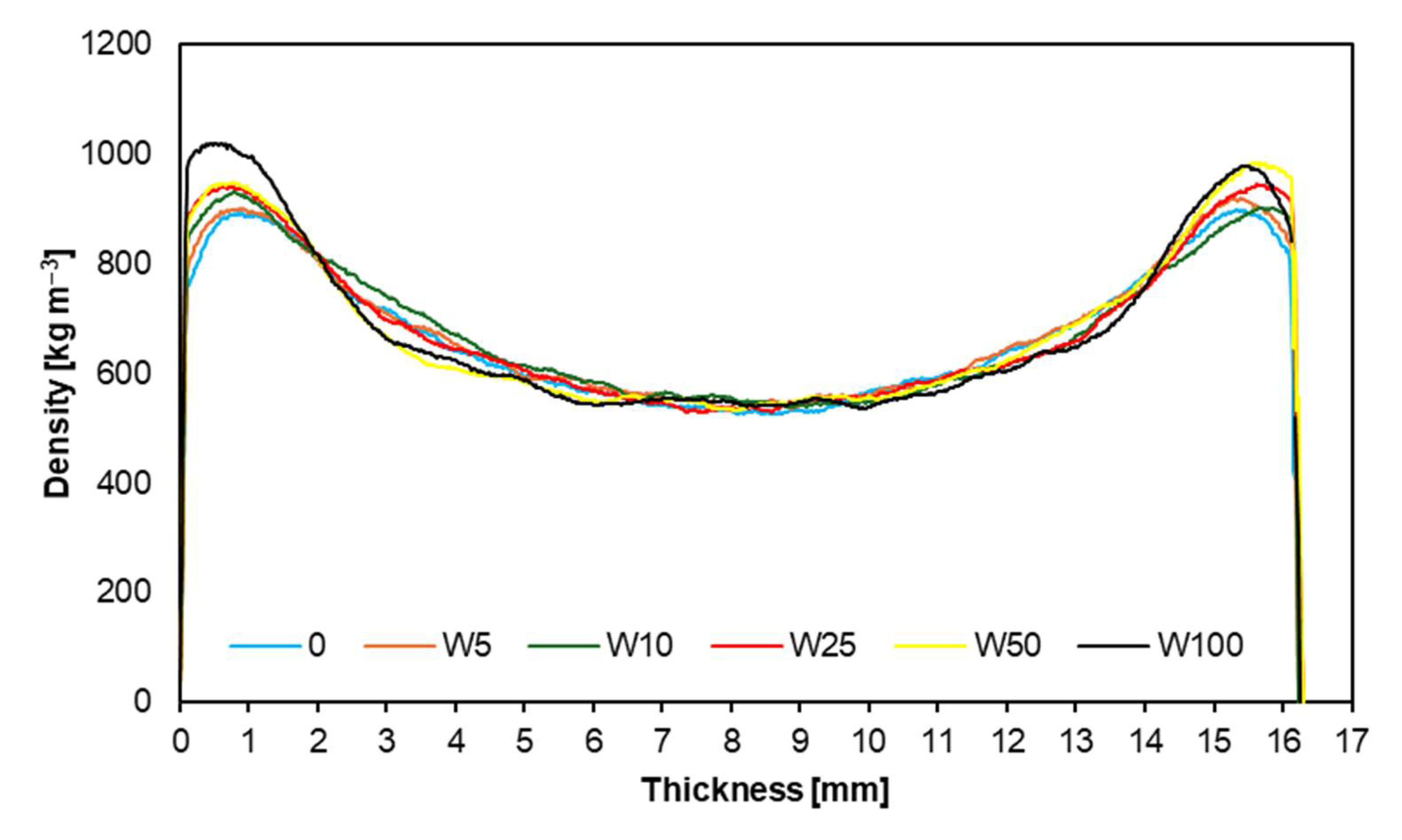
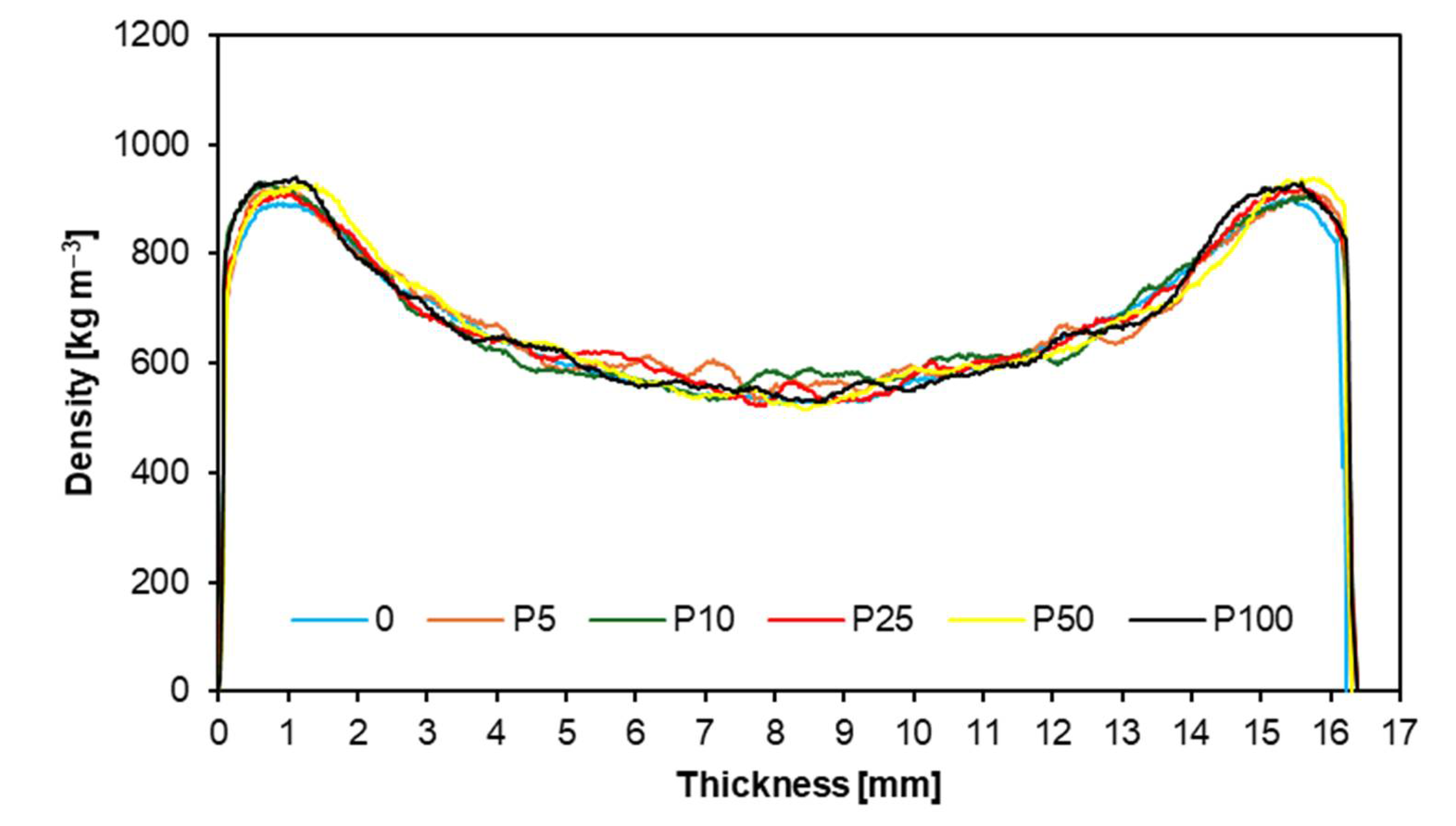
| Test type | Alternative raw material particles share [%] | ||||||||||
|---|---|---|---|---|---|---|---|---|---|---|---|
| 0 | 5 | 10 | 25 | 50 | 100 | ||||||
| W | P | W | P | W | P | W | P | W | P | ||
| MOE | a | a | a | a | a | a | a | b | a | c | b |
| MOR | a | b | c | c | c | b, c | c | c | c | c | b |
| IB | a | a | a | a, b | a | b | b | b | b, c | d | e |
| SWR | a | b | c | c | c | c | c | c | b | b | d |
| TS 2h | a | b | c | b | c | b | c | b | c | d | b |
| TS 24h | a | b | c | b | c, d | b | d | b | d | b | b |
| WA 2h | a | b | c | c | c | d | b, c | e | d | f | g |
| WA 24h | a | b | c | b | c | b | c | d | b | d | d |
Disclaimer/Publisher’s Note: The statements, opinions and data contained in all publications are solely those of the individual author(s) and contributor(s) and not of MDPI and/or the editor(s). MDPI and/or the editor(s) disclaim responsibility for any injury to people or property resulting from any ideas, methods, instructions or products referred to in the content. |
© 2024 by the authors. Licensee MDPI, Basel, Switzerland. This article is an open access article distributed under the terms and conditions of the Creative Commons Attribution (CC BY) license (http://creativecommons.org/licenses/by/4.0/).





